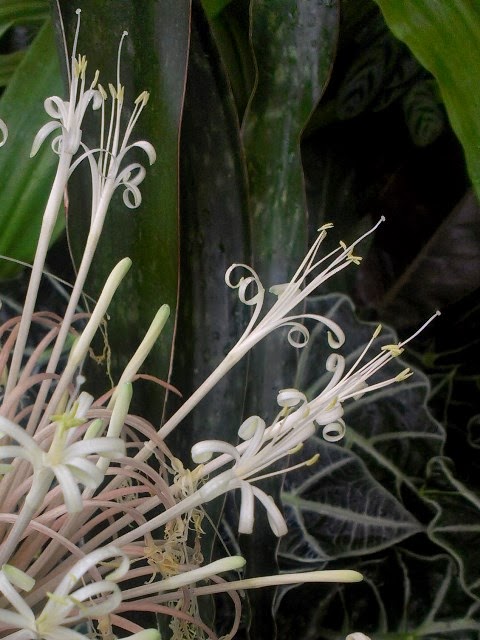Heavy metal mother-in-law's tongue flowers
We plant Sansevieria for its attractively patterned leaves (which stray awfully close to variegation, something you know my views on), its hardiness (it does come close to thriving on neglect) and its snickeringly humorous common name (Mother-in-law's Tongue).
Here's another reason to grow it - a spectacular bunch of flowers. In February we had this species, Sansevieria kirkii var. pulchra* in flower in Melbourne's Royal Botanic Gardens Tropical Glasshouse.
The flowers are actually in pairs or clusters of up to four, and these are grouped together into the stalked flowering structure you can see at the top.You seldom see them in flower, either in nature or in glasshouses. A few other species (e.g. Sansevieria trifasciata) flower more often, but even they are not reliable bloomers. And the result is hardly as pretty as our Sansevieria kirkii var. pulchra.
Mostly all you see of this plant is a couple of leaves variously blotched pale green or yellow. With age the discolouring fades. When I first wrote this blog I assumed the name on the plant label, Sansevieria metallica was correct and referred to the description of this species in a fan page of the Angiosperm Phylogeny Group III Asparagaceae subfamily Nolinoideae... They got their information from a 1915 review of the genus Sansevieria, published only 12 years after our species was first described and used. Yep, published scientific research published 99 years ago and still relevant.
Sadly for my catchy headline and my self esteem, that name is incorrect, and if I'd read the description properly (see my note* at the end of this post) I would have picked up the offending characteristic.
One of our nursery staff, David Robbins, tried to pollinate the flowers but was unable to find any pollen. Plenty of anthers but none of the gold dust. The female bits were sticky and ready, but sadly nothing for them to accept. In nature moths do this job, although not very well. Fruits are uncommon.
Because moths do it, the flowers are at there best in the evening. In fact in the morning all you get are spent flowers and buds, as in this picture I took just before lunch about mid-way through the flowering cycle. So you get a few waves of flowering, from about 3 pm each day, over a week.
Once the plant has flowered it no longer produces any new leaves. According to web gossip it doesn't die, like an Agave or Fucraea, but because the flower is produced by the leaf-producing growing tip there is no more action above the ground. The leaves remain as long as they remain undamaged and the plant may do a little expanding from underground stems called rhizomes.
Oh, and the species name (of my misidentification...) refers to the sheen on the leaves rather than any prescience about a rather poppy and popular heavy metal band a third as old as the review paper on Sansevieria. You do the math.
*Botanist Val Stajsic reassessed the identification of this specimen when it flowered in June 2015, discovering it was not Sansevieria metallica because the flowers are arranged in a 'capitate inflorescence' rather than a 'spike' (i.e. a head rather than a more elongate arrangement). He sent a photograph to Al Laius (the editor of 'CactusWorld', the journal of the British Cactus and Succulent Society) who confirmed Val's tentative identification of Sansevieria kirkii var. pulchra. As Mr Laius says, "the long strap-shaped leaves with a wavy reddish margin and the capitate raceme all add strength to this identification. S. metallica has a spike-like raceme."




Comments
Looks like there are more flower buds forming...
Best plants nursery
Best nursery for plantation